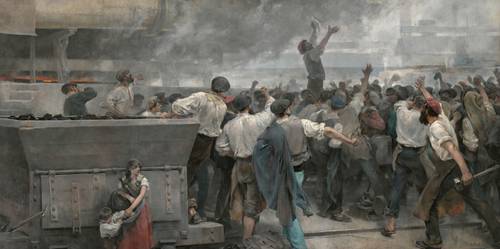Madrid. The Prado Museum inaugurated the exhibition Art and social transformations in Spain (1885-1910)in which it narrates, through pieces by Pablo Picasso, Sorolla, Gutiérrez Solana or Darío Regoyos and many other artists, the reality of the late 19th century and early 20th century, a turbulent period that was characterized by being the germ of the labor and union movements, the prelude to the great world wars, mass emigration due to economic depression, the decline of naturalism due to the emergence of new languages such as cinema or photography.
The Madrid art gallery had been considering for some time delving into the reading of its collection from the perspective of social art
; that is, the explanation of an era through the work, or vice versa, the narrative and its reason for being based on the moment in which it was conceived.
The pieces seek to explain the causes of popular revolts, union movements, emigration and discrimination against ethnic groups such as gypsies, the exploitation of women through prostitution or silent subjugation by the ancestral structures of society. All this reality, which occurred at a stage during which a new world emerged, that of the two blocks that marked the 20th century and the great world wars, was reflected in art, in photography, in thought and in feeling of the creators.
The exhibition seeks to show through 300 works – many of them unpublished, especially the photographs exhibited in galleries – the artists’ interpretations of the profound social transformation that was experienced between 1885 and 1910.
The immediate antecedent in aesthetic terms is the long period of predominance of history painting as the main inspiration. The diversity of techniques and creative registers that make up the exhibition allow us to show the great variety of artists’ responses to the challenge of representing the transformations of society in aspects that until then had hardly been discussed, such as industrial work and the inclusion of women in the world. labor, education, illness and medicine, poverty and ethnic and social marginalization, colonialism, strikes, anarchism and workers’ demands.
At that time, artists stopped dealing with historical issues to address their contemporaneity, so that their creations became a testimony of those changes. Inspired by photography, Spanish painters sought objectivity in representation, adopting a naturalistic style, similar to that which had triumphed in France and other countries, but with a singular identity, partly due to the influence of Velázquez and Goya.
The exhibition analyzes the different interpretations of this complex reality, as well as the mixture of techniques (photography, illustration and painting) and the crisis of the naturalistic representation system after the triumph of its most prominent authors, for example, the brothers Luis and José Jiménez Aranda, Vicente Cutanda, Joaquín Sorolla, Santiago Rusiñol and Ramon Casas.
One of the sections of the exhibition refers to prostitution, which in those years became a favorite subject of novelists and painters. It was associated with the representation of social injustice and exploitation, as in Joaquín Sorolla and Antonio Fillol and, later, with the boredom and vital distress of prostitutes, as in Gonzalo Bilbao, Ignacio Zuloaga and Julio Romero de Torres. The most innovative artists, who worked in Paris, such as Hermenegildo Anglada Camarasa and Pablo Picasso, addressed prostitution with more urban scenes, both on the street and in cafes and cabaret shows. In the restricted space of the brothel and also in the public space, disguised as entertainment, prostitution was tolerated, since its eradication was believed to be impossible, but its social consideration was totally negative.
The exhibition also delves into the emigration of the late 19th century, when more than 400,000 people left the country due to the deep economic depression and many of them came to seek a new life in Mexico and the rest of Latin America. Hence, the artists were inspired by the embarkation of the emigrants, also reflected in the photographs, the presence of the boats and ferries next to the large transatlantic steamers, the control forms of the emigrants, with their photographic identification, the figure of the Indiano and those of the repatriated.
